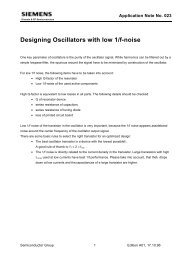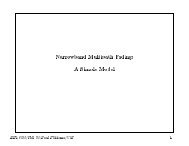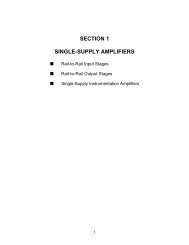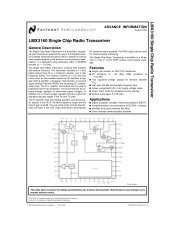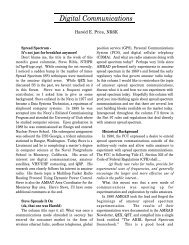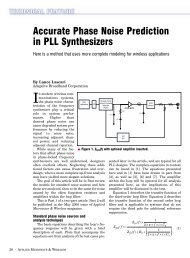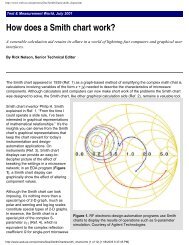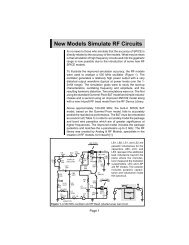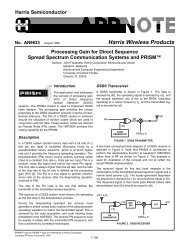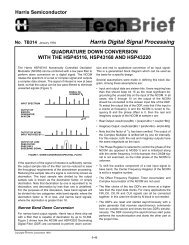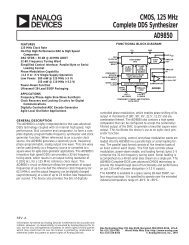Download HSP45102 12 Bit NCO Data Sheet
Download HSP45102 12 Bit NCO Data Sheet
Download HSP45102 12 Bit NCO Data Sheet
Create successful ePaper yourself
Turn your PDF publications into a flip-book with our unique Google optimized e-Paper software.
<strong>HSP45102</strong><br />
P0-1<br />
ENPHAC<br />
TXFR<br />
LOAD<br />
CLK<br />
4-DLY<br />
R<br />
E<br />
G<br />
R.P0-1<br />
R.ENPHAC<br />
R.TXFR<br />
CLK<br />
R<br />
E<br />
G<br />
R.LOAD<br />
PHASE OFFSET ADDER<br />
R.P0-1<br />
13 MSBs<br />
/<br />
A<br />
D<br />
D<br />
E<br />
R<br />
/ 13<br />
CLK<br />
‘0’<br />
R<br />
E<br />
G<br />
/ 32<br />
/ 32<br />
/ 13 R<br />
E<br />
G<br />
M<br />
U<br />
X<br />
/ 32<br />
SINE<br />
ROM / <strong>12</strong><br />
CLK<br />
2-DLY<br />
R<br />
E<br />
G<br />
OUT0-11<br />
SD<br />
SCLK<br />
SFTEN<br />
MSB/LSB<br />
SEL_L/M<br />
FREQUENCY<br />
CONTROL<br />
SECTION<br />
64-BIT<br />
SHIFT<br />
REG<br />
R.LOAD<br />
ACCUMULATOR<br />
INPUT<br />
FRCTRL<br />
REGISTER<br />
/ 32 0-31<br />
M / 32 R<br />
U<br />
E<br />
/ 32 FRCTRL<br />
32-63<br />
/ 32<br />
X<br />
R.TXFR<br />
G<br />
/ 32<br />
R / 32<br />
R.ENPHAC E<br />
G<br />
CLK<br />
(HIGH SELECTS FRCTRL0-31, LOW SELECTS FRCTRL32-63)<br />
PHASE ACCUMULATOR<br />
A<br />
D<br />
D<br />
E<br />
R<br />
FIGURE 1. <strong>NCO</strong>-<strong>12</strong> FUNCTIONAL BLOCK DIAGRAM<br />
Functional Description<br />
The <strong>NCO</strong><strong>12</strong> produces a <strong>12</strong>-bit sinusoid whose frequency<br />
and phase are digitally controlled. The frequency of the sine<br />
wave is determined by one of two 32-bit words. Selection of<br />
the active word is made by SEL_L/M. The phase of the output<br />
is controlled by the two-bit input P0-1, which is used to<br />
select a phase offset of 0, 90, 180, or 270 degrees.<br />
As shown in the Block Diagram, the <strong>NCO</strong><strong>12</strong> consists of a<br />
Frequency Control Section, a Phase Accumulator, a Phase<br />
Offset Adder and a Sine ROM. The Frequency Control section<br />
serially loads the frequency control word into the frequency<br />
register. The Phase Accumulator and Phase Offset<br />
Adder compute the phase angle using the frequency control<br />
word and the two phase modulation inputs. The Sine ROM<br />
generates the sine of the computed phase angle. The format<br />
of the <strong>12</strong>-bit output is offset binary.<br />
Frequency Control Section<br />
The Frequency Control Section shown in Figure 1 serially<br />
loads the frequency data into a 64-bit, bidirectional shift register.<br />
The shift direction is selected with the MSB/LSB input.<br />
When this input is high, the frequency control word on the<br />
SD input is shifted into the register MSB first. When<br />
MSB/LSB is low the data is shifted in LSB first. The register<br />
shifts on the rising edge of SCLK when SFTEN is low. The<br />
timing of these signals is shown in Figures 2A and 2B.<br />
The 64 bits of the frequency register are sent to the Phase<br />
Accumulator Section where 32 bits are selected to control<br />
the frequency of the sinusoidal output.<br />
Phase Accumulator Section<br />
The phase accumulator and phase offset adder compute the<br />
phase of the sine wave from the frequency control word and<br />
the phase modulation bits P0-1. The architecture is shown in<br />
Figure 1. The most significant 13 bits of the 32-bit phase<br />
accumulator are summed with the two-bit phase offset to<br />
generate the 13-bit phase input to the Sine Rom. A value of<br />
0 corresponds to 0 o , a value of 1000 hexadecimal corresponds<br />
to a value of 180 o .<br />
The phase accumulator advances the phase by the amount<br />
programmed into the frequency control register. The output<br />
frequency is equal to:<br />
F LO<br />
= ( N× F CLK<br />
⁄ 2 32 ), or<br />
(EQ. 1)<br />
⎛<br />
N INT F OUT⎞ 32 = ⎜--------------<br />
⎟ 2 ,<br />
(EQ. 2)<br />
⎝F CLK ⎠<br />
where N is the 32 bits of frequency control word that is programmed.<br />
INT[•] is the integer of the computation. For example,<br />
if the control word is 20000000 hexadecimal and the clock<br />
frequency is 30MHz, then the output frequency would be<br />
F CLK /8, or 3.75MHz.<br />
The frequency control multiplexer selects the least significant<br />
32 bits from the 64-bit frequency control register when<br />
SEL_L/M is high, and the most significant 32 bits when<br />
SEL_L/M is low. When only one frequency word is desired,<br />
SEL_L/M and MSB/LSB must be either both high or both<br />
low. This is due to the fact that when a frequency control<br />
word is loaded into the shift register LSB first, it enters<br />
through the most significant bit of the register. After 32 bits<br />
have been shifted in, they will reside in the 32 most significant<br />
bits of the 64-bit register.<br />
When TXFR is asserted, the 32 bits selected by the frequency<br />
control multiplexer are clocked into the phase accumulator input<br />
register. At each clock, the contents of this register are summed<br />
5-49



